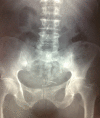[Intrauterine device: about a rare complication and literature review]
- PMID: 28904718
- PMCID: PMC5579437
- DOI: 10.11604/pamj.2017.27.193.13106
[Intrauterine device: about a rare complication and literature review]
Abstract
The intrauterine device (IUD) is the most common contraceptive method used in the world. Transuterine migration is a rare complication, accounting for 1/350 - 1/10000 insertions in the literature. We report the case of a 40-year old patient, who had had an IUD insertion 12-year before, presenting with pelvic and right lower back pain associated with intermittent hematuria and burning during urination. Radiological assessment showed calcific deposits on intra bladder IUD. The patient underwent cystostomy, without any difficulty, allowing stone and IUD extraction. A urinary catheter was left in place for 5 days and then withdrawn. The postoperative course was uneventful.
Le dispositif intra-utérin (DIU) constitue la méthode contraceptive la plus utilisée dans le monde. Sa migration trans-utérine est une complication rare et son incidence est estimée dans la littérature de 1/350 insertions à 1/10000 insertions. Nous rapportons le cas d'une patiente âgée de 40 ans, chez qui un DIU a été posé il y a 12 ans environ, ayant consulté pour des douleurs pelviennes et des lombalgies droites associées à une hématurie intermittente et des brûlures mictionnelles. Le bilan radiologique a mis en évidence un dispositif intra utérin calcifié en intra vésicale. Une cystotithotomie a été réalisée sans difficulté particulière permettant l'extraction du calcul et du DIU. Une sonde urinaire a été laissée en place pendant 5 jours puis retirée. Les suites opératoires ont été simples.
Keywords: Migration; bladder; intrauterine device.
Figures



Similar articles
-
Intravesical migration of intrauterine device.J Urol. 1992 Jan;147(1):132-4. doi: 10.1016/s0022-5347(17)37159-8. J Urol. 1992. PMID: 1729505
-
[Intrauterine device migrating to the bladder].Prog Urol. 2001 Dec;11(6):1289-91. Prog Urol. 2001. PMID: 11859668 French.
-
Migration of an intrauterine contraceptive device to the urinary bladder: sonographic findings.J Clin Ultrasound. 2002 Oct;30(8):496-8. doi: 10.1002/jcu.10098. J Clin Ultrasound. 2002. PMID: 12242738
-
[Migration of an intrauterine device into the bladder. Report of a case].J Gynecol Obstet Biol Reprod (Paris). 1999 May;28(2):162-4. J Gynecol Obstet Biol Reprod (Paris). 1999. PMID: 10416143 Review. French.
-
Ovarian embedding of a transmigrated intrauterine device: a case report and literature review.Arch Gynecol Obstet. 2009 Aug;280(2):275-8. doi: 10.1007/s00404-008-0882-2. Epub 2008 Dec 19. Arch Gynecol Obstet. 2009. PMID: 19096860 Review.
Cited by
-
Cause rare d’insuffisance rénale aigue: géant calcul de vessie chez une jeune femme: A rare cause of acute renal failure: giant urinary bladder stone in a young woman.Pan Afr Med J. 2018 Jan 3;29:4. doi: 10.11604/pamj.2018.29.4.14308. eCollection 2018. Pan Afr Med J. 2018. PMID: 29632626 Free PMC article. French.
-
Management of Intrauterine Device Migrated into the Bladder: A Case Report and Literature Review.Case Rep Urol. 2020 Oct 31;2020:8850087. doi: 10.1155/2020/8850087. eCollection 2020. Case Rep Urol. 2020. PMID: 33194240 Free PMC article.
-
Retrieval of a Missing Translocated Intrauterine Contraceptive Device Using Combined Laparoscopic and Cystoscopic Techniques.Case Rep Obstet Gynecol. 2024 Apr 15;2024:2017479. doi: 10.1155/2024/2017479. eCollection 2024. Case Rep Obstet Gynecol. 2024. PMID: 38716061 Free PMC article.
-
Intrauterine devices migrated into the bladder: two case reports and literature review.BMC Womens Health. 2021 Aug 16;21(1):301. doi: 10.1186/s12905-021-01443-w. BMC Womens Health. 2021. PMID: 34399735 Free PMC article. Review.
References
-
- Lansac J, Lecomte P, MarretARRET H. Gynécologie pour le praticien-6ème édition. Elsevier Masson. 2009;29(6):239.
-
- Tatum HG, Connel EB. A decade of uterine contraception: 1976 to 1986. Fertil Steril. 1986;46(2):173–192. - PubMed
-
- Haouas N, Sahraoui W, Youssef A, Thabet I, Mosbah AT. Intravesical migration of intrauterine device resulting in stone formation. J Gynecol Obstet Biol Reprod. 2006;35(3):288–292. - PubMed
-
- Chartzwald D, Mooppan UM, Tancer ML, Gomezleon G, Kim H. Vesicouterine fistula with menouria: a complication from an intrauterine contraceptive device. J Urol. 1986;136(5):1066–1067. - PubMed
-
- Joual A, Querfani B, Taha A, El Mejjad A, Frougui Y, Rabii R, Debbagh A, El Mrini M. Intravesical migration of an intrauterine contraceptive device complicated by stones. Prog Urol. 2004 Jun;14(3):374–5. - PubMed
Publication types
MeSH terms
LinkOut - more resources
Full Text Sources
Other Literature Sources
